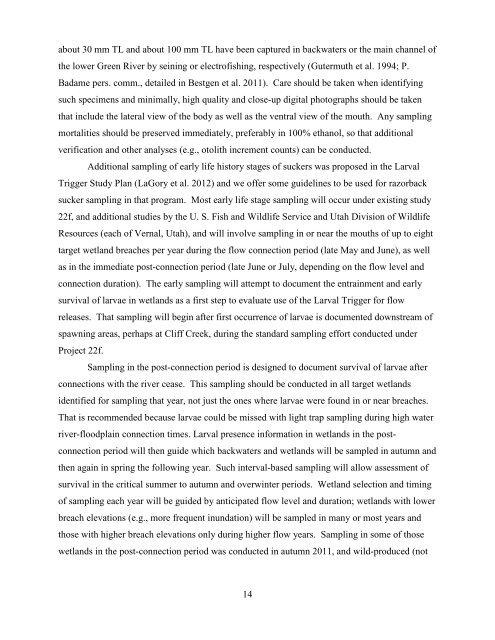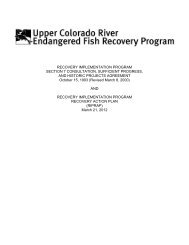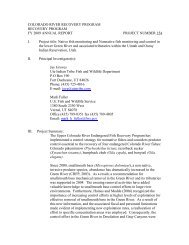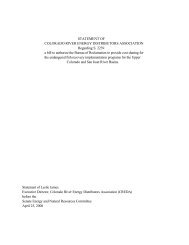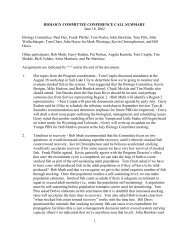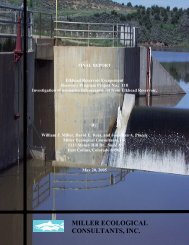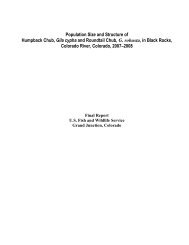K. R. Bestgen, K. A. Zelasko, and G. C. White. Monitoring ...
K. R. Bestgen, K. A. Zelasko, and G. C. White. Monitoring ...
K. R. Bestgen, K. A. Zelasko, and G. C. White. Monitoring ...
You also want an ePaper? Increase the reach of your titles
YUMPU automatically turns print PDFs into web optimized ePapers that Google loves.
about 30 mm TL <strong>and</strong> about 100 mm TL have been captured in backwaters or the main channel of<br />
the lower Green River by seining or electrofishing, respectively (Gutermuth et al. 1994; P.<br />
Badame pers. comm., detailed in <strong>Bestgen</strong> et al. 2011). Care should be taken when identifying<br />
such specimens <strong>and</strong> minimally, high quality <strong>and</strong> close-up digital photographs should be taken<br />
that include the lateral view of the body as well as the ventral view of the mouth. Any sampling<br />
mortalities should be preserved immediately, preferably in 100% ethanol, so that additional<br />
verification <strong>and</strong> other analyses (e.g., otolith increment counts) can be conducted.<br />
Additional sampling of early life history stages of suckers was proposed in the Larval<br />
Trigger Study Plan (LaGory et al. 2012) <strong>and</strong> we offer some guidelines to be used for razorback<br />
sucker sampling in that program. Most early life stage sampling will occur under existing study<br />
22f, <strong>and</strong> additional studies by the U. S. Fish <strong>and</strong> Wildlife Service <strong>and</strong> Utah Division of Wildlife<br />
Resources (each of Vernal, Utah), <strong>and</strong> will involve sampling in or near the mouths of up to eight<br />
target wetl<strong>and</strong> breaches per year during the flow connection period (late May <strong>and</strong> June), as well<br />
as in the immediate post-connection period (late June or July, depending on the flow level <strong>and</strong><br />
connection duration). The early sampling will attempt to document the entrainment <strong>and</strong> early<br />
survival of larvae in wetl<strong>and</strong>s as a first step to evaluate use of the Larval Trigger for flow<br />
releases. That sampling will begin after first occurrence of larvae is documented downstream of<br />
spawning areas, perhaps at Cliff Creek, during the st<strong>and</strong>ard sampling effort conducted under<br />
Project 22f.<br />
Sampling in the post-connection period is designed to document survival of larvae after<br />
connections with the river cease. This sampling should be conducted in all target wetl<strong>and</strong>s<br />
identified for sampling that year, not just the ones where larvae were found in or near breaches.<br />
That is recommended because larvae could be missed with light trap sampling during high water<br />
river-floodplain connection times. Larval presence information in wetl<strong>and</strong>s in the postconnection<br />
period will then guide which backwaters <strong>and</strong> wetl<strong>and</strong>s will be sampled in autumn <strong>and</strong><br />
then again in spring the following year. Such interval-based sampling will allow assessment of<br />
survival in the critical summer to autumn <strong>and</strong> overwinter periods. Wetl<strong>and</strong> selection <strong>and</strong> timing<br />
of sampling each year will be guided by anticipated flow level <strong>and</strong> duration; wetl<strong>and</strong>s with lower<br />
breach elevations (e.g., more frequent inundation) will be sampled in many or most years <strong>and</strong><br />
those with higher breach elevations only during higher flow years. Sampling in some of those<br />
wetl<strong>and</strong>s in the post-connection period was conducted in autumn 2011, <strong>and</strong> wild-produced (not<br />
14


